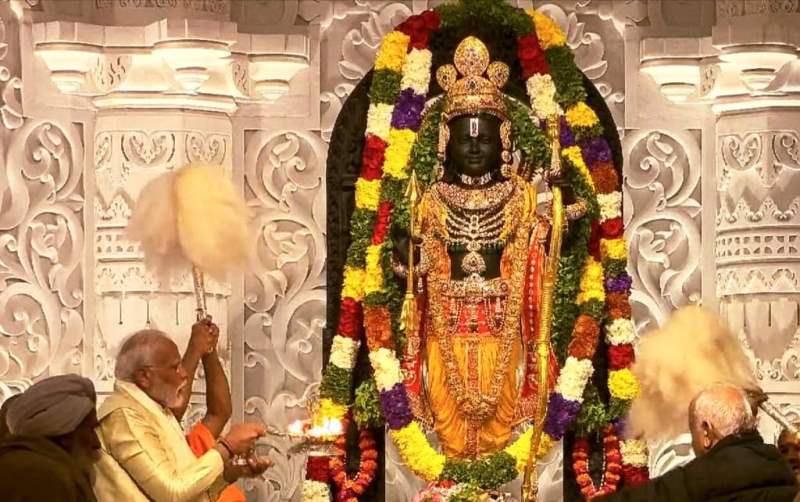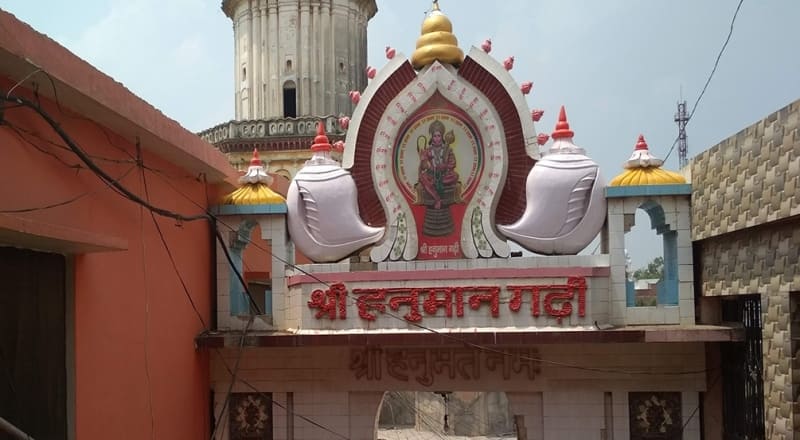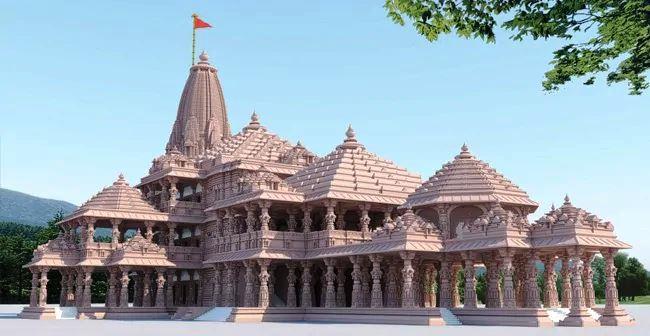Best Places to Visit in Ayodhya: Ram Mandir (राम मंदिर, अयोध्या)
Updated on 22 January 2024 by Rishabh kumar
Ayodhya Uttar Pradesh India
Ayodhya is a city situated on the banks of holy river Saryu. In the Indian state of Uttar Pradesh, It is the headquarter of Ayodhya District and Ayodhya division. Ayodhya, also known as Saket, is an ancient city of India, is the birthplace of Bhagwan Shri Ram and setting of the great epic Ramayana. Ayodhya used to be the capital of the ancient Kosala Kingdom. It has an average elevation of 93 meters (305 feet). Owing to the belief as the birthplace of Bhagwan Shri Ram, Ayodhya (Awadhpuri) has been regarded as first one of the seven most important pilgrimage sites (Mokshdayini Sapt Puris) for Hindus.
Ayodhya is among the many ancient cities of India carrying in itself, a glorious past to boast about. Lying along the Sarayu River, Ayodhya is popular for being a major pilgrimage destination in Hinduism, revered for being the birthplace of Lord Ram, the seventh avatar of Lord Vishnu, who is also considered to be the ideal man with his virtues and conduct. A major travel destination for the followers of Ram, Ayodhya's Ram Janmabhoomi is what attracts hordes of them every year. The land is also believed to have been the dwelling place of Goswami Tulsidas as well, the author of the esteemed 'Ramcharitmanas'. Ayodhya's soil and culture also has the influence of the many Nawabs that once ruled the marvelous city as Awadh.
Tourism in Ayodhya: The Land of Lord Ram
Tourism in Ayodhya is primarily driven for being the place where Lord Ram appeared on the earthly dwelling. Lord Ram's birthplace at Ayodhya or the Ram Janmabhoomi is one of the popular pilgrimage destinations in India. The human avatar of Lord Vishnu, Lord Ram is highly revered across the world and attracts a number of devotees throughout the year, who come to Ayodhya to receive his blessings. The ideal son, brother, and the ideal husband, there are a number of places in the city dedicated to Lord Ram. Read along to find out the best places to visit in Ayodhya to make the most of your visit to the holy city.
Among the best places to visit in Ayodhya is Ramkot. It is the site of an ancient citadel that once marked Lord Ram's fort. Built on a higher ground than the rest of the city, Ramkot offers amazing views of the entirety of Ayodhya and its ghats, making it one of the popular places to explore in the city. Abundant with numerous temples and shrines, Ramkot is a major religious site in Ayodhya, with pilgrims who visit from all over the world to pay offerings to Lord Ram.
Ram Janmabhoomi is considered to be one of the most important pilgrimage destinations in India for the followers of Hinduism. Counted among the 'Sapta Puri' or the seven most-holy Hindu destinations in the country, the Ram Janmabhoomi is revered for being the birthplace of Lord Ram. According to Ramayana, Lord Ram was born at the site, along the banks of the Sarayu River at Ayodhya. After a long series of political disputes, over many years, the Janmabhoomi will finally witness the glory of the magnificent Ram Mandir on its soil and will be a boon for the city's religious tourism.
Kanak Bhawan is one of the popular Hindu temples located in Ayodhya. Honoring Lord Ram, the temple also worships his consort, Goddess Sita. The site is a popular point of interest for the worshippers of Hinduism. The innermost sanctorum houses three pairs of gold colored idols of the divine couple, decorated with abundant jewelry of gold, thus earning the name, 'Kanak Bhawan' or a 'House of Gold'.
Holding religious significance, the Sarayu River can be found in the Ramayana and the Vedas, closely associated with Lord Ram. A tributary of the holy River Ganges, bathing in the Sarayu River is said to wash away one's sins. Among the many ghats dotted along the river, the Guptar Ghat is the most popular one for being the place where Lord Ram took Jal Samadhi while leaving his earthly abode.
Best Time to Visit Ayodhya
The best time to visit Ayodhya is between the months of October and March when the weather is colder and pleasant. It is the peak season for tourism in the city since these months bring various Hindu festivities. In the months of April to June, Ayodhya can get extremely hot and is not ideal for travel, and so it is best to avoid travel. The city experiences monsoon from July to September. There might be fewer crowds as compared to other months but the weather can get pretty humid.
Best 10 Places to Visit in Ayodhya
Ayodhya has a rich history and holds great religious significance for all Indians. According to the great epic, Ramayana, Ayodhya is believed to be the place where Lord Ram was born.
There are many amazing places to visit in Ayodhya, including holy ghats, ancient temples and monuments of religious importance. Since the city has a close association with Hindu Mythology, many devotees visit the city throughout the year.
If you visit Ayodhya, here are some of the best places you should visit:

1.Sree Ram Janmabhoomi Mandir
The Sree Ram Janmabhoomi Mandir is a sacred location that must not be missed. According to Hindu tradition, the Ram Janmabhoomi, which translates as "Ram's Birthplace," is believed to have been the location of Lord Ram's birth. According to the Indian epic Ramayana, Ram, Lord Vishnu's seventh avatar, has grown up beside the Sarayu River, which flows through Ayodhya, where he is said to have been born. The Ram Janmabhoomi land, which had been a source of contention for decades, was finally transferred to a trust by the Supreme Court of India to construct the Ram Temple. The planned design for the temple is abundant and spectacular in its scale and scope. The Prime Minister of India, Narendra Modi, held the groundbreaking ceremony to lay the foundation stone for the Ram Temple in Ayodhya on the 5th of August in the year 2020.
The Ram Janmabhoomi site was the former location of the Babri Masjid, which is now a national monument. It is claimed that the Mughals razed a Hindu sanctuary to construct this mosque at the site of Lord Ram's birthplace. In 1992, Hindu nationalists demolished the Babri Masjid, igniting a sequence of deadly riots throughout India that continued for years. In October 2019, a Supreme Court panel of five justices ruled that the land be transferred to a trust to construct the Ram Temple. The Sunni Waqf Board was also allocated 5 acres of property to construct a mosque.

2.Hanuman Garhi
Hanuman Garhi is a Hindu temple dedicated to the Hindu God Hanuman located in Sai Nagar. The temple dates back to the 10th century. In Ayodhya, it is considered one of the most significant temples since it is usual to visit Hanuman Garhi before visiting the Ram Temple. It is claimed that Lord Hanuman still resides in this temple and protects Ayodhya.
The hilltop temple's 76-staircase route to the door is a work of art. A 6-inch-tall Hanuman statue stands amid a panoramic picture of the surrounding hills and is housed within the panoramic view. The main temple's inner cave is embellished with countless sculptures of Lord Hanuman and his mother, Maa Anjani, worshiped here. Each year, thousands of pilgrims go to the Hanuman Garhi to commemorate the birth of Lord Ram and Lord Hanuman on their respective feast days, Ram Navami and Hanuman Jayanti.
3.Kanak Bhawan
Located in Tulsi Nagar, near the Sree Ram Janmabhoomi Mandir, the Kanak Bhawan is erected in the northeastern part of the complex. This temple, also known as Sone-ka-Ghar, was built in 1891 and is dedicated to the Hindu god Lord Rama and his wife, Goddess Sita.
The sanctum sanctorum of Kanak Bhawan, also known as the Golden Palace, has three golden-crowned statues of the two gods under a silver dome, which represents the palace of gold (Garbagriha). It is said that Kaikeyi, Rama's stepmother, gave this temple to Rama and Sita as a gift to commemorate their marriage.
Following a planned refurbishment during Vikramaditya's reign, the current location was completely renovated by Vrishbhanu Kunwari, who also designed the original structure. The Sri Vrishbhan Dharma Setu Trust Private Limited is presently in charge of the administration of this temple in the Bundela style.
4.Nageshwarnath Temple
The Nageshwarnath Temple, built in the name of the local god, Lord Nageshwarnath, is next to the Theri Bazaar in Ayodhya and is dedicated to him. Traditionally, it is believed to have been established byKush or Kusha, the son of Lord Rama.
During the festivals of Mahashivaratri and Trayodashi, also known as Pradosh Vrat or Pradosh Vratam, in Southern India, the Nageshwarnath Temple attracts numerous devotees. However, even though this hallowed place has been well-maintained since 750 AD, the present temple is supposed to have been renovated in 1750 by Naval Rai, Safar Jung's minister. According to legend, Kush came across a Shiva devotee named Naga Kanya while bathing in the local bathhouse and conversed with him. Upon discovering that the latter had fallen in love with him, he built this Shaiva shrine for Naga Kanya to commemorate the occasion.
5.Gulab Bari
The Gulab Bari, also known as theGarden of Roses, is located in the Vaidehi Nagar neighborhood. It contains the tomb of Nawab Shuja-ud-Daula, the third Nawab of Faizabad (Oudh or Awadh), as well as the tombs of his parents. You can find here pure Nawab-styled architecture in the 18th-century structure of the Gulab Bari, which also features a vast array of rose species and fountains and lush greenery. Gulab Bari, which is protected as a national monument under the Ancient Monuments and Archaeological Sites and Remains Act, is currently being preserved as a part of the country's cultural heritage.
There are steps leading to the higher floor, but since these stairs are now in poor condition, most people are not permitted to go to the upper story at this time. In the tomb of Nawab Shuja-ud-Daula and the burial of Shuja-ud-Daula, the tombs of his parents may be found as well. His mother's burial is to the left of Shuja-ud-tomb, Daula's, while his father's grave is to the right of his mother's grave. These tombs are located on the ground level and are covered with wood with intricate carvings. Later, they changed the location of his father's tomb to Delhi. Tourists are drawn to Mughal architecture because of its unique spirit. Visiting Gulab Bari enhances the historical, cultural, and architectural attractiveness of a trip destination's itinerary by providing more historical, cultural, and architectural charm.
6.Guptar Ghat
Guptar Ghat is a decent place in Faizabad, near Ayodhya, and is located on the Sarayu River banks, also known as Ghaggar. In the past, this ghat was a neighbor to the colonial Company Gardens, which is today known as Gupta Ghat Van. Guptar Ghat, located on the River Saryu, is a sacred site with significant religious importance. By mythology, this was the location where Lord Rama took his last plunge (Jal samadhi) before departing this world and returning to his original dwelling, 'Baikuntha.
The Sita-Ram temple, the Chakra hari shrine, and the Narsingh temple are among the most well-known of the several temples in this area. The Guptar Ghat, rebuilt in the 1800s and continuously improved by the Uttar Pradesh government, is now provided with contemporary facilities.
It is a widely held notion among devotees that taking a bath in the Saryu river at this ghat would wash away their sins and alleviate their anxieties about the outside world. The ghat is filled with Lord Rama's name chanting throughout the day as devotees and priests sing songs in adoration of their lord. Raja Mandir and Chakra Hari Vishnu Temple are also nearby. The Guptar Ghat is a popular tourist destination, bordered by temples dedicated to Ram Janki, Charan Paduka, Narasingh, and Lord Hanuman. Raja Darshan Singh constructed Ghats during the first part of the nineteenth century.
7.Treta Ke Thakur Temple
The Treta Ke Thakur Temple, located near the Naya Ghat of Ayodhya, is home to several idols, including Lord Ram, Sita, Lakshman, Hanuman, Bharat, and Sugreev, among others. One black sandstone block is said to have been used to carve out each of these sculptures.
Treta Ke Thakur is believed to have been built 300 years ago by Kullu, the region's king. It is said that this structure stands on the same ground as the famous Ashwamedha Yagna, which was performed by Lord Rama thousands of years ago. Ahilyabai Holkar was a Maratha queen who reigned during the 1700s and made further improvements to the temple.
It is only open to the public once a year, on the day known as Ekadashi, and for a limited time only. According to the Hindu calendar, this day is observed on the eleventh day of the Shukla Paksha in the month of Karthika. On this day, vibrant celebrations are held in conjunction with preserving traditional practices.
8.Choti Chawni
Choti Chawni, also known as Valmiki Bhawan, stands as a magnificent architectural marvel with its 34 heritage caves. Divided into Buddhist, Hindu, and Jain sections, this site showcases the intricate beauty of ancient Indian civilizations. The Kailasha Temple within the caves adds to the artistic brilliance, creating a harmonious blend of cultural influences. Despite the wear and tear of time, Choti Chawni remains a testament to the architectural prowess and cultural diversity of ancient Ayodhya.
9.Tulsi Smarak Bhawan
The Tulsi Smarak Bhawan was built to commemorate Goswami Tulsidas, a saint-poet living in the 16th century. The Smarak, located on the eastern end of the National Highway near Rajgang Crossing in Ayodhya, was constructed in 1969 by Sri Vishwanath Das, the Governor of Uttar Pradesh. It is said to have been where Tulsidas produced the Ramcharita, a collection of poems.
Along with the huge library, which is a treasure trove of valuable literature, the Smarak also includes a research center known as the 'Ayodhya Research Sansthan', which is dedicated to the study of Ayodhya. It is used to research and add meaning to Ayodhya's literary, cultural, and spiritual knowledge and to study and add meaning to other material. The center also hosts a daily recitation of Ramkatha and an exhibition of Ramayana art and craft.
A great collection of facts, statistics, and antiquities about the life and times of Lord Sri Ram were added by the government in 1988, and the Ram Katha Sanghralaya is a museum that houses the collection. Tulsi Jayanti is celebrated with much pomp and circumstance on the seventh day of the month of Shravan, in addition to the customary prayers, devotional songs, and discourses.
10.Raja Mandir
Raja Mandir in Faizabad, which is located on the banks of the river Ghaggar (Sarayu) near Guptar Ghar, has been linked to countless mythical legends time and time again. The temple is home to magnificently sculpted idols of various Hindu Gods and Goddesses, all of whom are lavishly ornamented with silken fabrics and precious jewellery.
The temple's beautiful building exemplifies the brilliance of Hindu architectural design at its best. The shrine, formerly famed for its link with Lord Sri Ram, the monarch of Ayodhya, is now a typical temple, with sculptures of various deities on display. Raja Mandir is situated right on the edge of the river creating a captivating reflection of the shrine in the waters, a sight for the eyes. Many tourists come to this location every year.
Other Best Places in India:-









